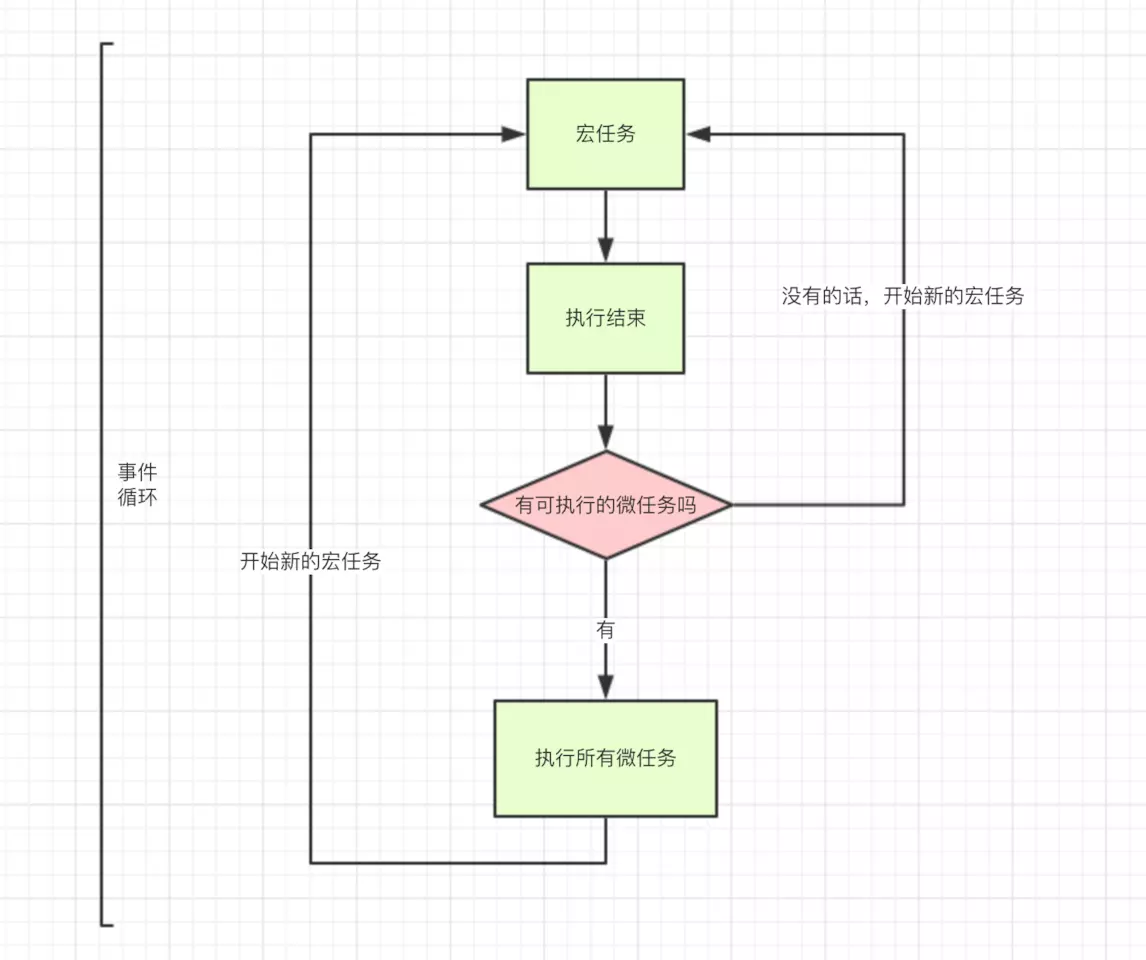弄懂 JavaScript 执行机制
- macro-task(宏任务):包括整体代码script,setTimeout,setInterval
- micro-task(微任务):Promise,process.nextTick
不同类型的任务会进入对应的Event Queue,比如setTimeout和setInterval会进入相同的Event Queue。
事件循环的顺序,决定js代码的执行顺序。进入整体代码(宏任务)后,开始第一次循环。接着执行所有的微任务。然后再次从宏任务开始,找到其中一个任务队列执行完毕,再执行所有的微任务。听起来有点绕,我们用文章最开始的一段代码说明:
setTimeout(function() { console.log('setTimeout'); }) new Promise(function(resolve) { console.log('promise'); }).then(function() { console.log('then'); }) console.log('console');
-
这段代码作为宏任务,进入主线程。
- 先遇到
setTimeout,那么将其回调函数注册后分发到宏任务Event Queue。(注册过程与上同,下文不再描述)。 - 接下来遇到了
Promise,new Promise立即执行,then函数分发到微任务Event Queue。 - 遇到
console.log(),立即执行。 - 好啦,整体代码script作为第一个宏任务执行结束,看看有哪些微任务?我们发现了
then在微任务Event Queue里面,执行。 - ok,第一轮事件循环结束了,我们开始第二轮循环,当然要从宏任务Event Queue开始。我们发现了宏任务Event Queue中
setTimeout对应的回调函数,立即执行。 - 结束。
事件循环,宏任务,微任务的关系如图所示:

我们来分析一段较复杂的代码,看看你是否真的掌握了js的执行机制:
console.log('1');
setTimeout(function() {
console.log('2');
process.nextTick(function() {
console.log('3');
})
new Promise(function(resolve) {
console.log('4');
resolve();
}).then(function() {
console.log('5')
})
})
process.nextTick(function() {
console.log('6');
})
new Promise(function(resolve) {
console.log('7');
resolve();
}).then(function() {
console.log('8')
})
setTimeout(function() {
console.log('9');
process.nextTick(function() {
console.log('10');
})
new Promise(function(resolve) {
console.log('11');
resolve();
}).then(function() {
console.log('12')
})
})
第一轮事件循环流程分析如下:
- 整体script作为第一个宏任务进入主线程,遇到
console.log,输出1。 - 遇到
setTimeout,其回调函数被分发到宏任务Event Queue中。我们暂且记为setTimeout1。 - 遇到
process.nextTick(),其回调函数被分发到微任务Event Queue中。我们记为process1。 - 遇到
Promise,new Promise直接执行,输出7。then被分发到微任务Event Queue中。我们记为then1。 - 又遇到了
setTimeout,其回调函数被分发到宏任务Event Queue中,我们记为setTimeout2。
| 宏任务Event Queue | 微任务Event Queue |
| setTimeout1 | process1 |
| setTimeout2 | then1 |
- 上表是第一轮事件循环宏任务结束时各Event Queue的情况,此时已经输出了1和7。
- 我们发现了
process1和then1两个微任务。 - 执行
process1,输出6。 - 执行
then1,输出8。
好了,第一轮事件循环正式结束,这一轮的结果是输出1,7,6,8。那么第二轮时间循环从setTimeout1宏任务开始:
- 首先输出2。接下来遇到了
process.nextTick(),同样将其分发到微任务Event Queue中,记为process2。new Promise立即执行输出4,then也分发到微任务Event Queue中,记为then2。
| 宏任务Event Queue | 微任务Event Queue |
| setTimeout2 | process2 |
| then2 |
- 第二轮事件循环宏任务结束,我们发现有
process2和then2两个微任务可以执行。 - 输出3。
- 输出5。
- 第二轮事件循环结束,第二轮输出2,4,3,5。
- 第三轮事件循环开始,此时只剩setTimeout2了,执行。
- 直接输出9。
- 将
process.nextTick()分发到微任务Event Queue中。记为process3。 - 直接执行
new Promise,输出11。 - 将
then分发到微任务Event Queue中,记为then3。
| 宏任务Event Queue | 微任务Event Queue |
| process3 | |
| then3 |
- 第三轮事件循环宏任务执行结束,执行两个微任务
process3和then3。 - 输出10。
- 输出12。
- 第三轮事件循环结束,第三轮输出9,11,10,12。
整段代码,共进行了三次事件循环,完整的输出为1,7,6,8,2,4,3,5,9,11,10,12。
原文地址:https://juejin.im/post/59e85eebf265da430d571f89#heading-8